Isobel Neviazsky
Interview by Caitlin Merrett King
-
Published January 2020
-
Isobel Neviazsky is an artist, writer and musician based in Glasgow. She publishes as Tin Beetle Books and is one half of Sunboy Toys with Katie Lundie. Her recent exhibition, Some Pictures, was the inaugural exhibition at my gallery Lunchtime in July 2019. I was, and still am, fascinated by her prolific and rigorous practice, making for the pure joy of making and with a strong focus on accessibility and affordability.
-
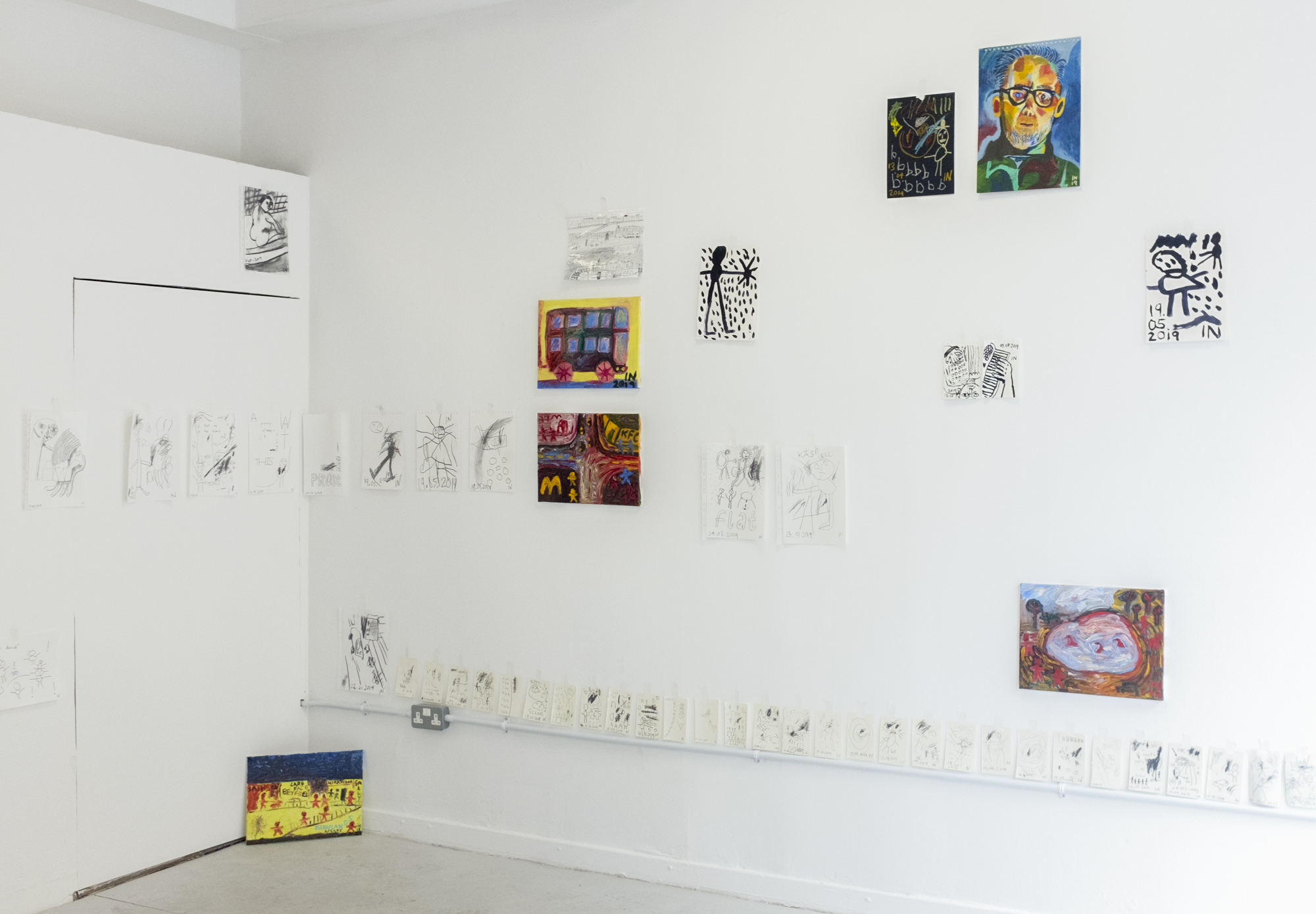
Some Pictures, installation view, Lunctime, Glasgow, 2019
Isobel, drawing is the basis to your practice and when I came to see your studio before the exhibition at Lunchtime you showed me hundreds and hundreds of archived drawings in folders. Can you talk a bit about your relationship to drawing as a medium?
I think for me drawing is the most immediate way of making something. For some reason it feels more direct than painting, probably because it’s faster because you don’t have to put paint on a brush and because it’s more direct it feels like a truer way of expressing myself. I think probably the purity of the pencil as my base instrument also lends itself to immediacy. Most of the time I don’t use a rubber and would just keep adding to a drawing to balance the picture rather than labouring over getting a line right as what I find most interesting when I’m making a picture is the way the elements are reacting to each other and it becomes a game almost.
I like the simplicity of materials required and the fact you can do it anywhere and that the materials are easily available. I like that drawings are easy to store, especially because I have a lot of them. I tend to work on A4 or smaller paper because I can fit them into ring binders but would definitely make larger works more often if I had a way of storing them.

Some Pictures, installation view, Lunctime, Glasgow, 2019
I like the idea of the process of making a drawing being like a game that you're playing almost against yourself and your own internal logic is dictating where you place each element. That feels therapeutic and you say that it's a truer way of expressing yourself as well.
I'm thinking about that desire to document experiences as a way of processing them and to what end? Like what does it do to note down all these experiences and collect them in a way? Like in ‘EMPLOYEE OF THE MONTH: the life of a pizza chef’, the publication of drawings and writing you made about working at a pizza restaurant. The whole experience of doing that job was really intense for you, but by drawing it and compiling the drawings, do you see that as a way of processing that experience?
I’m not sure if it’s necessarily a desire to document my life rather than just a desire to draw, and if something interesting is happening then I like to draw that thing. Both ‘EMPLOYEE OF THE MONTH: the life of a pizza chef’ and ‘ankle mush’ were drawings about my life over a specific time period which were then later collected together into a book. I don’t think that making the books is a way of processing the experience it’s more that I think these sets of drawings are good and work best displayed together and I would like to be able to share the work with others, so a book made sense.
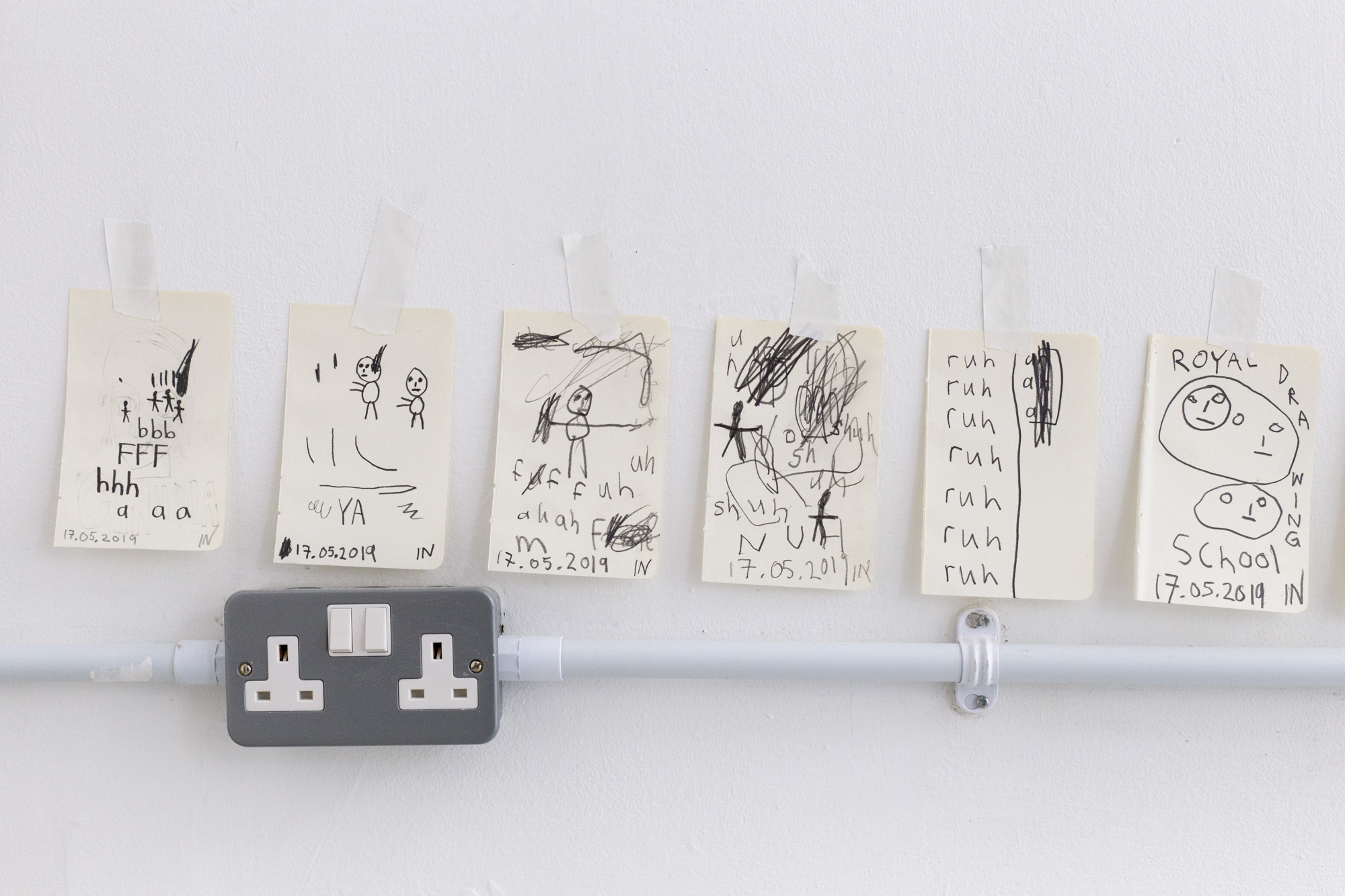
Some Pictures, installation view, Lunctime, Glasgow, 2019
The publication you made for 'The Intrigue of the Flea' was a way of sharing the work with others, and because the show was only on for a short amount of time, it means more people can see the work, it gives the work a new life after the show and it's also a way to make money. Accessibility and affordability are really important to you, can you talk about why this is?
The problem with an exhibition is it’s a limited amount of time, with a book there isn’t a time limit and you can return to it again and again over the years. There’s differences between each format but each has their benefits and I treat them both in the same way when I’m making them. I also don’t think it’s lesser to see a work just in reproduction. Most of the art I look at is in reproduction and that doesn’t mean I can’t get anything from it.
It was important for me to make the catalogue for The Intrigue of the Flea to document that exhibition, when I make an exhibition that’s the same as making a drawing. The configuration of drawings and paintings is probably never to be repeated and is a compositional balancing act the same as a drawing.
I don’t really go into book making as a money making venture, because there’s not really money in it, and the sales are slow to make a return. It’s more important to be able to share the work and to cover costs is enough, and when I end up in profit from sales I just use that to be able to make more books.
Affordability and accessibility is important to me because I want people to be able to enjoy my work. If my work is unaffordable nobody could own it and then it sits in my cupboard or in a ring binder for years with all the other paintings or drawings and if someone can have my work in their home and it brings them joy that’s great. Instagram is a tool where I can share my work to people for free, books are a way people can buy a lot of pictures for not much money and the individual artworks I price based on how much I would be happy for that artwork to not be in my life anymore.
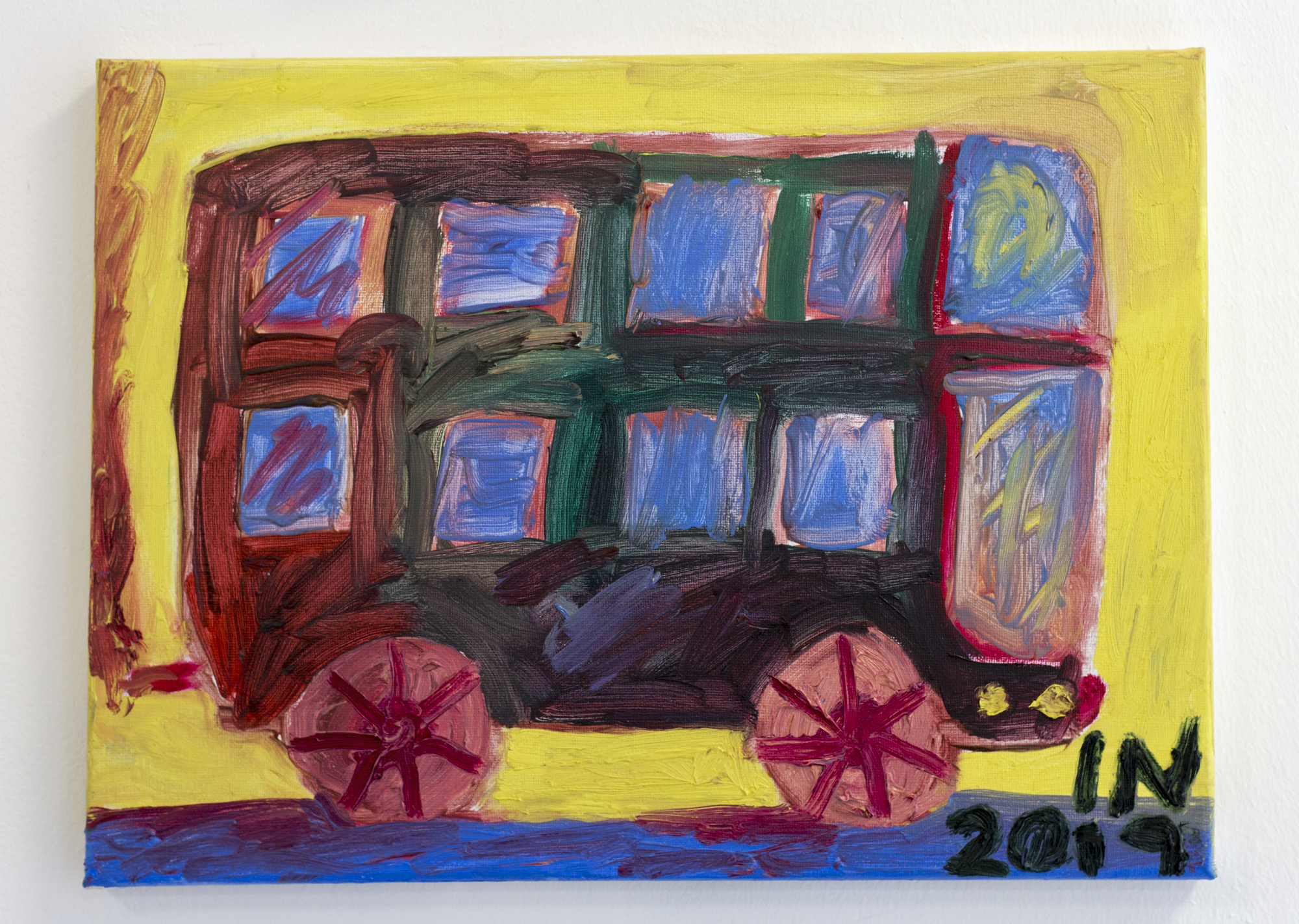 Bus, oil on canvas, 2019
Bus, oil on canvas, 2019 I think that's super important, also the conversation about selling or buying art work isn't often very visible on an artist-led, smaller institutional level. I like how up front you are on Instagram about your work being for sale, Instagram functions as an online catalogue of your work. Another part of your practice is doing portrait commissions, which are also priced in an affordable and transparent way. Do you see these as separate to your practice in any way?
I think that my relationship with the commissions changes, I’ve had a lot of difficulty with them.
I don’t want to get too specific to certain commissions but people could be very demanding and difficult, you would assume that people commissioning me are familiar with the kind of things I make. But I would be asked to change things to make them more realistic. Because people were paying me to make an artwork for them I felt I had to make all these changes (which at times I felt compromised my artwork) and because I was being pushed further to something I didn’t feel was genuinely my expression led me to feel separate from the commissions. I wanted the commissions to be affordable but when they were developing into the more detailed ones with more back and forth and more changes I wasn’t earning minimum wage on the paintings and they were seriously effecting my mental health too. I had a few breakdowns because of working on the portraits, and I’ve since changed how I work on commissions now as well as increasing the price to pay myself fairly and although I get much less commissions I enjoy working on them more now.
I had a very difficult time relating to the paintings and they felt like a completely separate part of my practice. I’m proud of a lot of these paintings now I have a bit of distance and I wouldn’t say they are separate entities.
I had a bit of difficulty dealing with the shift in how my work began to look during this period but now I’m quite glad, it’s just another way of working (and I still create work in the old way). Some days when I work I just feel like looking at things in great detail now and I find that a lot of fun.
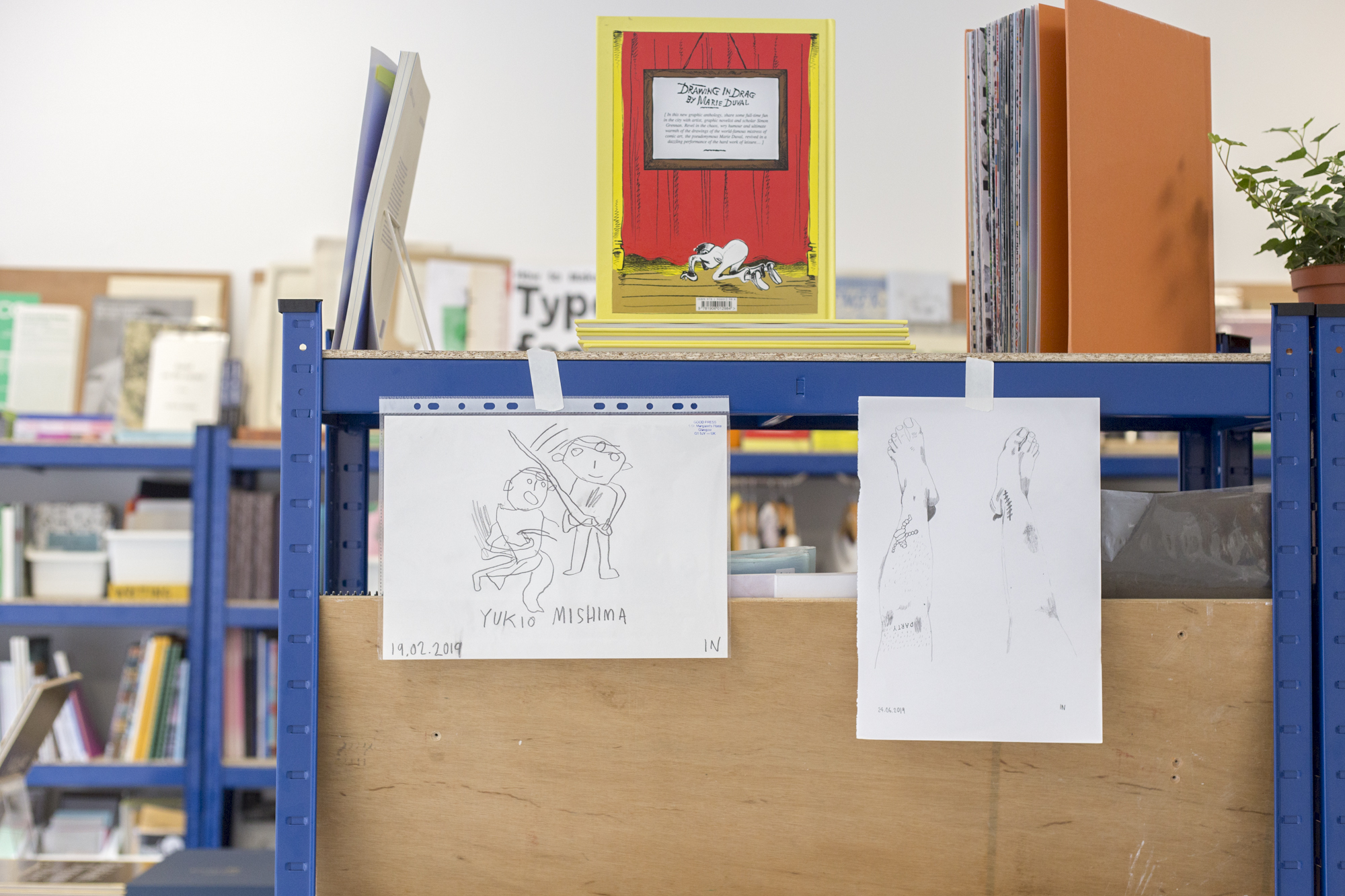 Yukio Mishima & Self Portrait, pencil on paper, 2019
Yukio Mishima & Self Portrait, pencil on paper, 2019Thanks for being so honest about your relationship with the commissions, I’m glad you’re feeling better about them now, like you’ve made that work better for you rather than compromising your health. When we talked about what work should be included in ‘Some Pictures’ that was a big part of the discussion, like how do the commissions, drawings, other paintings relate to each other as part of your practice. I had initially invited you to re- exhibit the ‘The Intrigue of the Flea’ exhibition at Basic Mountain but we decided against it. Could you talk a bit about that exhibition and the influence of William Blake on that body of work?
Working from other art is one of the few things that I do that tend to be recurring but not a continual focus. I think I rotate through these things and at different times I can get more obsessed by one of these facets and then get bored and then do the other stuff. The main visual themes are working from life (portraits or still life), working from other art, and what I call drawings about drawings which is the other stuff.
So in general when working from other art it’s pretty nice because I don’t have to think about a composition and I can focus just on drawing.
With Blake his compositions are often dense or just visually I think he’s the complete opposite of me as far as two artists working with figures can be and there’s something interesting in the pictures when I’m interpreting his pictures, that collision or abrasion just makes pictures that I like.
I can’t remember exactly when I returned to the Blakes but I think I was really burnt out from commissions in 2018. I can feel really bad if I’m not making stuff, mentally and physically sick and I was feeling terrible because of the position the commissions had put me into and I wasn’t able to make anything and by working from Blake I was able to start again. I did a few paintings and drawings and was getting quite obsessed because it’s intoxicating when I’m working on things that make me feel all these things. Anyway I ended up with loads of these pictures and at this point in time I’d been quite hermetic for ages and was only sharing works on instagram but I felt like I needed to show people these pictures. At some point I can’t remember Naomi asked me if I’d like to do something at Basic Mountain. She’s really generous and kind and gave a lot of support that I really needed to guide me through the process of putting myself out there and putting my work on display and I am so happy for it. It felt like a huge step for me at the right time where I began to respect my work a bit more again after feeling so down. Basic Mountain is such a beautiful space and it was great to be able to play with a big room compared to the wall in my studio, allowing me to see my work in a new way. Her amazing support and the amazing positive responses I got from people who managed to see the show gave me quite a bit more self confidence.
I had originally thought that I would like to bring the show to back to Glasgow in another form, but I think that show felt like a finish of sorts for the work. I’m sure at some point the Blakes may come back but for now I’m interested in different things.
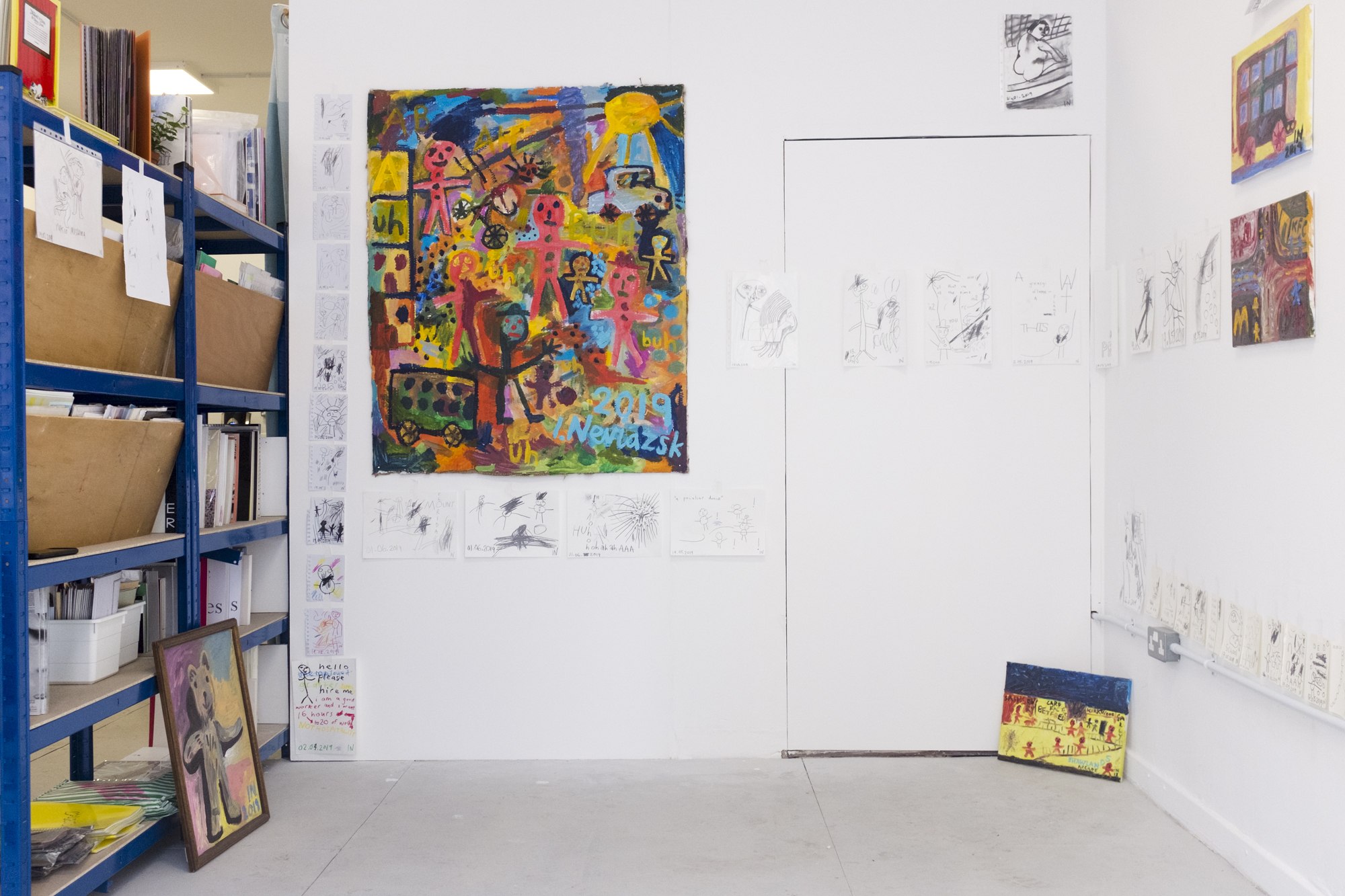 Some Pictures, installation view, Lunctime, Glasgow, 2019
Some Pictures, installation view, Lunctime, Glasgow, 2019That stepping back from your work, out of the studio and into a gallery context is so important, especially for someone like you who is so prolific I think, and because you want people to see and enjoy your work! ‘Some Pictures’ felt almost like a retrospective in a way, there was loads of work on show, one portrait commission, some new oil paintings on canvas and a lot of smaller drawings. It was so fun to play around with these and you talked about how you want to treat curating the same as you would making and balancing a drawing which makes a lot of sense to me too. And it almost felt like looking at your instagram as well, I got the same feeling of excitement anyway about the breadth of work you are making. How do you feel about the show on reflection now?
I’m proud of the show and it was a lot of fun to compose. In the run up to the show we were discussing how the different aspects of my work still felt quite different to me and I realised it was important to be able to put some of every type together to break down that barrier in my head. It was good to have that variety and being able to display them in a cohesive and considered way instead of the instagram feed made me realise that they all work together. It’s kind of like a jigsaw putting it together, and I was really happy when it came together and the flow of the works.
Yes it was so much fun, I’m really glad you enjoyed the process. It was so nice getting to know you through the process and see how you work. I love how that curator-artist relationship challenges my own ways of working as well. Making the exhibition map for 80+ works was fun too haha. I think the only thing we’ve not touched on is sunboy toys which is a collaboration with your partner Katie, when did you guys start making together?
Yeah I felt quite bad about the exhibition map and all the really long or annoying titles but I’m glad you didn’t mind.
Sunboy Toys started in 2017 when we were making a Christmas present for a friend. It was really nice to be able to work on something together, which I think can be quite difficult to do sometimes. It works quite naturally and we make a good team on it, we both enjoy making them and seeing how each one comes out. We use recycled materials, mainly clothes from charity shops or fabrics we get given and the combinations we come up with and the fact that we have a limited amount of each fabric keeps it interesting. Basically we just really like how nice and friendly they look and people seem to like it too!
 G flat & KÄSE, pencil on paper, 2019
G flat & KÄSE, pencil on paper, 2019Yes they're such a beautiful presents and a lovely collaboration that really feels like it is equally yours and Katie's styles using each of your skills appropriately also. Another thing we've not talked about is the Wetherspoons Drawing Club! How did that come about?
Wetherspoons Drawing Club began because I'd often meet friends for a coffee and a draw and thought having a larger group could be a nice way to spend a few hours. I like the social aspect and obviously I like drawing and there's something really nice about drawing alongside other people.
It's nice to have an informal get together with drawing as a focus. Wetherspoons was chosen because unlike a cafe it's not really a problem if you sit there for hours, unlike a library it's fine to be loud and there are free refills on coffee. Originally they were every fortnight and around Glasgow, I would ask people if they wanted to make a poster and they could choose the venue. A lot of the meetings ended up being at one specific spoons because a lot of people seem to live nearby and it's often quieter than the venues in the city centre which can end up being difficult to get a table.
We did one zine as a group which was everyone's interpretation of one picture of Tim Martin and we're trying to work on new zines too because it's nice to have a collection of art by the different people who come together in the meetings.
I've had to wind down a bit because I just had a baby so can't commit as much time - I've tried to make it self sustaining where other people can host the meetings too and I will post the poster but I think it really just needs one person to drive it. Hopefully I'll get back to hosting them soon.
I like how casual it is and there's no pressure to draw if you don't want to, you can just watch your pals drawing and have a cheap drink. The Tim Martin zine is great, also a good way of addressing the problematics of going to Wetherspoons, but occupying the space in that way feels quite radical. And it's a great sustainable model that you've gifted to people, like anyone can host it in whichever Wetherspoons they like, you don't necessarily have to be there yourself. And you can rinse the bottomless coffee.
-
www.tinbeetle.net
-
If you like this why not read our interview with Cristina Mejías
-
© YAC | Young Artists in Conversation ALL RIGHTS RESERVED
